Why Is My Monstera Plant Drooping? Troubleshooting Guide!
Your Monstera plant is likely drooping due to factors like overwatering or underwatering. Overwatering causes root rot and hinders nutrient uptake, while underwatering leads to dehydration and wilted leaves.
Poor lighting conditions, temperature fluctuations, and inadequate humidity also contribute to drooping. Ensure your plant receives bright, indirect light and maintains a stable temperature.
Root issues such as poor soil quality or root rot can hinder growth and cause drooping. Additionally, inspect for pest infestations, provide balanced fertilization, and check for physical damage.
Understanding these factors helps diagnose and address the drooping effectively. There are more nuanced reasons and strategies to explore ahead.
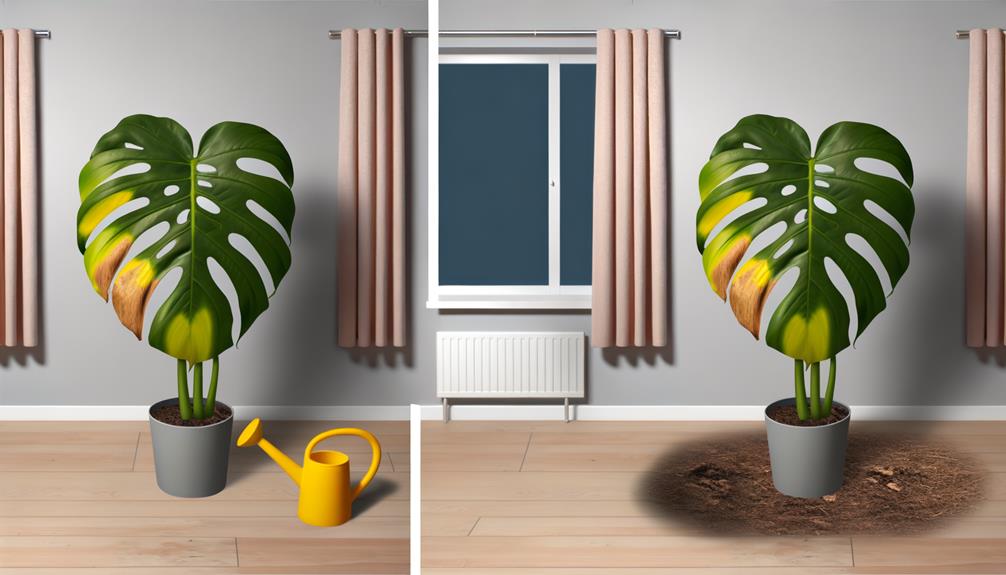
Key Takeaways
- Overwatering leads to root rot and impaired nutrient uptake, causing drooping leaves.
- Underwatering results in limp leaves and dry soil, indicating dehydration.
- Inadequate lighting causes stunted growth and drooping leaves; ensure bright, indirect light for 6-8 hours daily.
- Extreme temperature fluctuations and improper heating sources stress the plant, leading to drooping leaves.
- Poor soil quality and compacted roots hinder nutrient uptake, causing drooping and stunted growth.
Overwatering
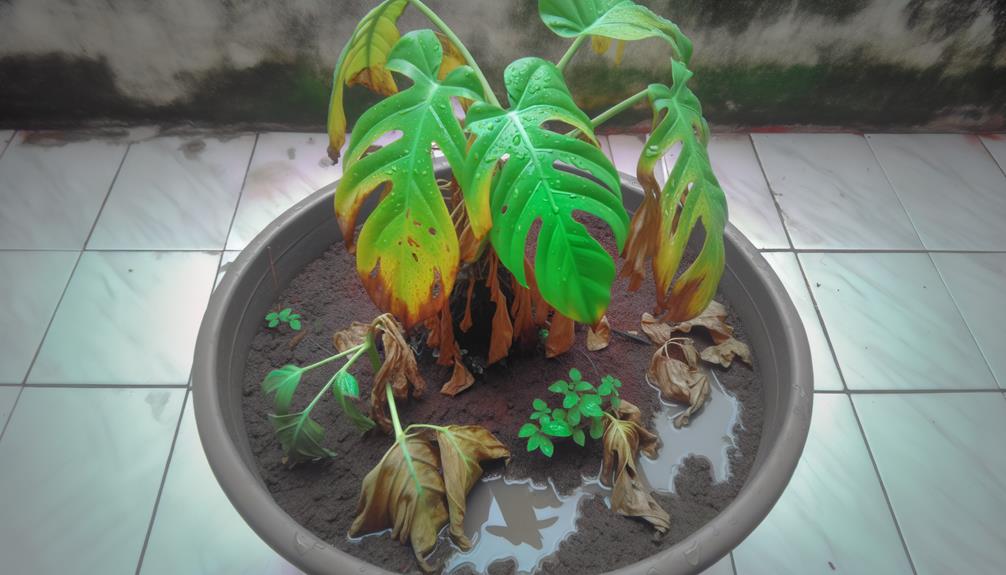
Overwatering is frequently the primary cause of a drooping Monstera plant, leading to root rot and impaired nutrient uptake. When you water excessively, the soil becomes waterlogged, depriving roots of oxygen. This anaerobic environment fosters fungal growth, particularly Pythium and Phytophthora species, which decimate root systems.
Without healthy roots, your Monstera can’t absorb essential nutrients and water, resulting in wilting leaves and stunted growth.
To diagnose overwatering, check the soil moisture using a probe or your finger. If the top inch is still wet, hold off on watering. Ensure your pot has proper drainage and consider using a well-aerated soil mix.
Underwatering
You’ll notice signs of dehydration in your Monstera when the leaves become limp and the soil feels dry to the touch.
To maintain ideal soil moisture levels, establish a consistent watering schedule based on the plant’s specific needs.
Monitoring the soil with a moisture meter can help prevent underwatering and promote healthy growth.
Signs of Dehydration
When a Monstera plant is dehydrated, its leaves will often become limp and curl inward, indicating a severe lack of water. You’ll notice the foliage losing its characteristic firmness and vibrant green color, turning dull or even yellow.
This wilting is primarily due to the plant’s inability to maintain turgor pressure in its cells. The soil will likely appear dry and may pull away from the edges of the pot, exacerbating root stress.
Additionally, the stems may droop or bend unnaturally, and new growth can appear stunted or fail to emerge. It’s fundamental to act promptly, as prolonged dehydration can lead to irreversible damage, affecting the plant’s overall health and robustness.
Watering Frequency Tips
Ensuring your Monstera plant receives the correct watering frequency is essential for preventing underwatering and maintaining its best health. Underwatering can lead to drooping leaves, stunted growth, and overall plant stress. To avoid this, you should adhere to a consistent watering schedule that meets your Monstera’s needs.
Consider these tips:
- Monitor environmental conditions: Temperature and humidity levels directly impact the plant’s water requirements.
- Evaluate pot size and material: Smaller pots and porous materials like terracotta dry out faster.
- Adjust seasonally: Monstera plants typically require less water during dormant winter months and more during active growth periods in spring and summer.
Soil Moisture Levels
To accurately determine if your Monstera is suffering from underwatering, assess the soil moisture levels by using a moisture meter or inserting your finger about two inches deep into the soil. If the soil feels dry or the meter reads low, the plant likely suffers from insufficient hydration.
Monstera plants thrive in consistently moist, well-draining soil; dryness can lead to drooping leaves. Maintain a regular watering schedule, allowing the top inch of soil to dry out between watering sessions.
Additionally, consider the pot’s drainage capacity—poor drainage can exacerbate underwatering symptoms. Employing a systematic approach to monitoring soil moisture prevents underwatering and guarantees your Monstera remains healthy and vibrant.
Inadequate Lighting
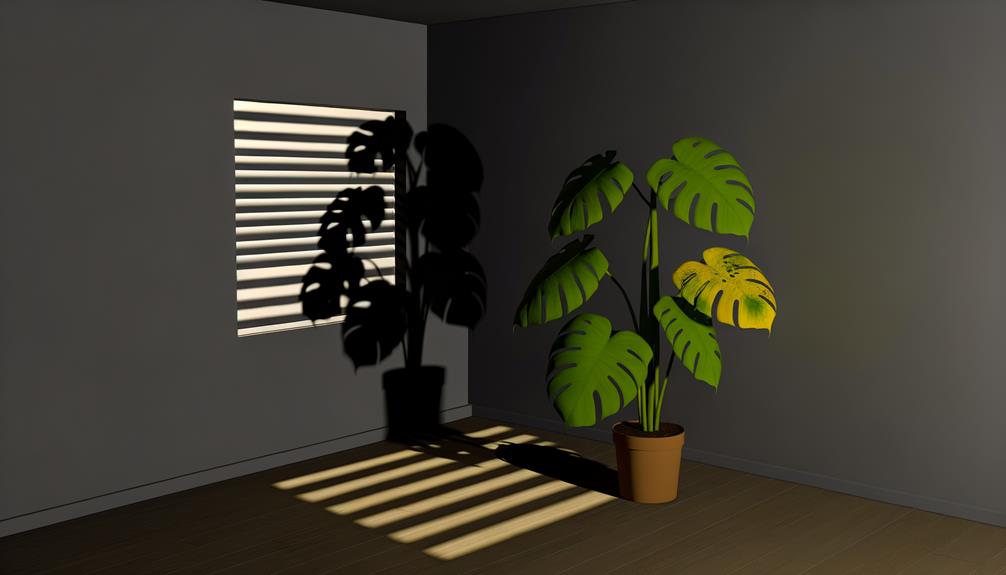
Insufficient light exposure often leads to a Monstera plant exhibiting drooping leaves and stunted growth. When your Monstera doesn’t receive sufficient light, its photosynthetic efficiency diminishes, resulting in reduced energy production. You’ll need to identify suitable corrective measures.
- Light Intensity: Ensure exposure to bright, indirect sunlight. Direct sunlight may scorch leaves, while too little light hinders growth.
- Duration of Exposure: Aim for at least 6-8 hours of light daily. Natural light is ideal, but artificial grow lights can supplement during darker months.
- Placement: Position your plant near east or west-facing windows. You can also rotate the plant periodically to maintain even light distribution.
Addressing these factors will help your Monstera thrive and reduce drooping.
Temperature Stress
When your Monstera experiences extreme temperature fluctuations, its cellular structure can become stressed, leading to drooping leaves.
Inadequate humidity levels exacerbate this issue, causing further hydration imbalance.
Additionally, improper heating sources can cause localized overheating, damaging the plant’s foliage and overall health.
Extreme Temperature Fluctuations
Extreme temperature fluctuations can cause significant stress to Monstera plants, resulting in drooping and other signs of distress. Monstera plants thrive in stable environments, so when temperatures swing dramatically, their physiological processes can become disrupted.
This stress can manifest in several ways:
- Leaf Droop: Rapid temperature changes can cause water loss and cellular damage, leading to drooping leaves.
- Growth Stagnation: Consistent fluctuations hinder metabolic activities, stalling overall growth.
- Leaf Discoloration: Temperature stress can lead to chlorosis, where leaves turn yellow due to impaired chlorophyll production.
To mitigate these issues, monitor the ambient temperature closely and maintain a consistent range. Avoid placing your Monstera near drafts, heating vents, or windows with direct sunlight exposure to secure a stable microclimate.
Inadequate Humidity Levels
Just as temperature fluctuations can stress a Monstera plant, inadequate humidity levels also play an essential role in causing leaf droop and other signs of distress.
Monsteras are tropical plants that thrive in environments with 60-80% humidity. When humidity levels fall below this range, the plant’s stomata close to conserve water, disrupting transpiration and photosynthesis. This results in drooping leaves and stunted growth.
You can monitor humidity using a hygrometer and increase levels with a humidifier or misting. Additionally, placing a water tray near the plant can help.
Ensuring adequate humidity is vital for maintaining the plant’s physiological functions, promoting robust growth, and preventing stress-induced symptoms. Adjust your indoor environment to meet your Monstera’s humidity needs.
Improper Heating Sources
Heating sources that emit irregular or excessive warmth can cause significant temperature stress, leading to Monstera plant drooping and other signs of distress.
Check that your Monstera isn’t exposed to:
- Radiators: These release dry, intense heat that can scorch leaves.
- Drafts from windows or doors: Sudden temperature changes can shock the plant.
- Proximity to HVAC vents: Forced air systems can create uneven heating, straining the plant.
Monitor the surrounding temperature around your Monstera, maintaining a consistent range between 65°F to 75°F (18°C to 24°C). Fluctuations outside this range can disrupt the plant’s metabolic processes, causing drooping. Using a thermometer can assist you in maintaining a stable environment.
Humidity Levels
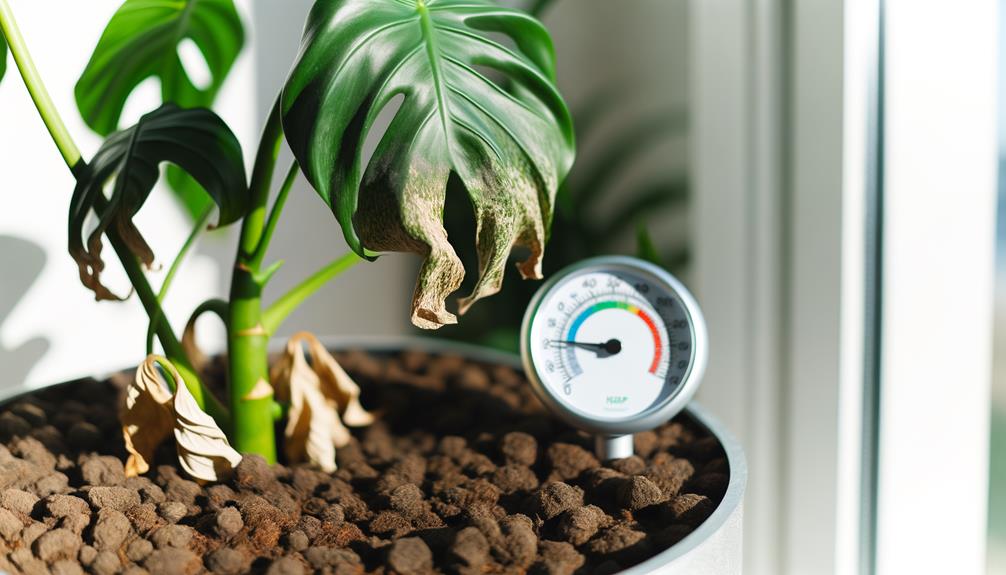
Maintaining ideal moisture levels is vital for preventing your Monstera plant from drooping, as these tropical plants flourish in environments with moisture-rich air. Aim for a relative moisture level of 60-80%. You can measure this using a hygrometer.
If the air is too dry, the stomata on the leaves may close, reducing photosynthesis and causing drooping. Increase moisture by misting the leaves regularly, using a pebble tray with water, or employing a humidifier. Grouping plants together can also create a microenvironment with higher moisture.
Ensure your Monstera isn’t placed near heating vents or air conditioners, as these can significantly reduce ambient moisture levels, exacerbating the drooping issue. Monitoring and adjusting moisture is essential for optimal plant health.
Poor Soil Quality
You’ll need to assess the soil quality if your Monstera is drooping, as poor soil can lead to nutrient deficiency issues, a compacted root system, and inadequate drainage. These factors inhibit proper growth and water absorption, directly impacting the plant’s health.
Ensuring well-aerated, nutrient-rich soil with good drainage is essential for maintaining a healthy Monstera.
Nutrient Deficiency Issues
Poor soil quality can lead to drooping in Monstera plants due to nutrient deficiencies. The struggle to absorb essential minerals necessary for growth is evident when the soil lacks nutrients like nitrogen, potassium, and phosphorus.
This diminishes the plant’s vitality. To diagnose nutrient deficiency, observe symptoms such as yellowing leaves, browning leaf edges, and stunted growth.
- Yellowing Leaves: Indicates nitrogen deficiency, affecting chlorophyll production.
- Browning Leaf Edges: Points to potassium deficiency, crucial for water regulation.
- Stunted Growth: Suggests phosphorus deficiency, essential for energy transfer.
You can address these deficiencies by amending the soil with a balanced, slow-release fertilizer. Regularly testing your soil’s pH is crucial since nutrient uptake is highly pH-dependent. Ensuring ideal soil health is paramount for maintaining a robust, droop-free Monstera.
Compacted Root System
When the root system of your Monstera becomes compacted, it restricts the plant’s ability to absorb water and nutrients, leading to drooping and overall poor health. Compaction occurs when soil particles are pressed tightly together, limiting root expansion and gas exchange. Evaluating soil quality is essential for diagnosing this issue.
| Symptom | Analysis |
|---|---|
| Drooping Leaves | Limited nutrient and water uptake |
| Stunted Growth | Restricted root expansion |
| Yellowing Foliage | Poor oxygenation and nutrient deficiency |
| Hard Soil Surface | Indicates compaction and poor drainage |
To alleviate this, consider repotting your Monstera in a well-draining soil mix that promotes aeration. Use a soil that contains components like perlite, bark chips, or peat moss to enhance root health and prevent future compaction.
Inadequate Drainage
Promoting proper drainage in your Monstera’s soil mix is crucial for preventing waterlogging and root rot, which can result in drooping leaves and overall plant decline. Substandard soil quality often lacks the aeration and permeability required for healthy root systems.
You should consider the following:
- Amend the soil: Integrate perlite or orchid bark to enhance drainage.
- Inspect the pot: Confirm it has sufficient drainage holes to facilitate the release of excess water.
- Utilize a well-draining mix: Choose a premium potting mix specially formulated for aroids.
Pot Size Issues
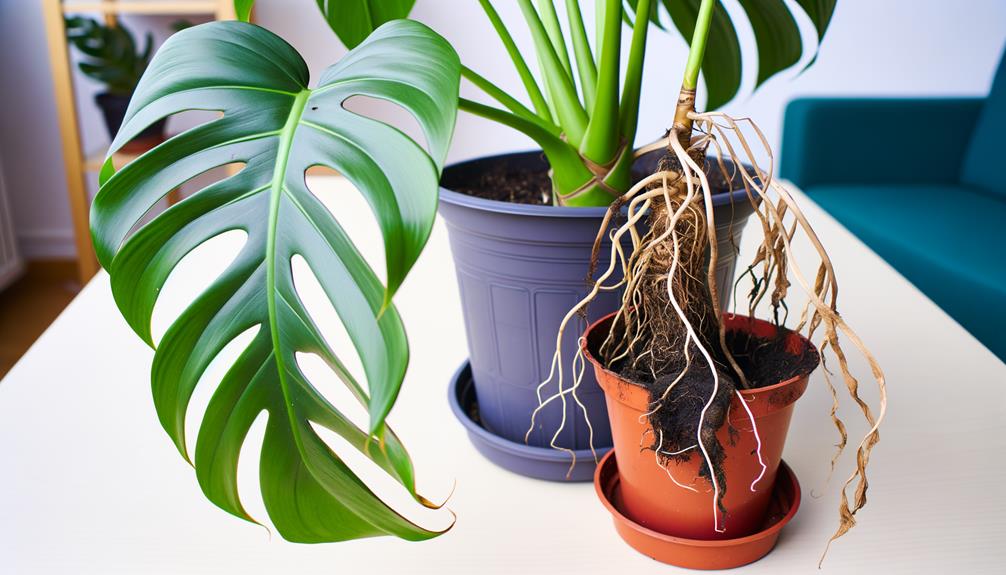
Choosing an inappropriate container size can greatly contribute to your Monstera plant drooping by either limiting root growth or causing waterlogging. A container that’s too small confines roots, leading to nutrient deficiencies and stunted growth. Conversely, an oversized container retains excess moisture, promoting root stress.
| Container Size | Root Condition | Plant Response |
|---|---|---|
| Too Small | Root-bound | Restricted growth |
| Too Large | Excess moisture | Root stress |
| Ideal | Optimal root space | Healthy growth |
Analyzing the correlation between container size and root conditions is crucial. When the container is properly sized, roots have sufficient space to expand, promoting efficient nutrient uptake and water drainage. Always make sure your Monstera’s container matches its growing requirements to maintain its essentiality and prevent drooping.
Root Rot
Root rot, a common affliction in Monstera plants, often results from overwatering and poor drainage, leading to decayed roots and drooping foliage. You’ll need to recognize the signs early to prevent irreversible damage.
Key indicators include:
- Brown, mushy roots: A clear sign of rot, indicating anaerobic conditions.
- Foul odor: Decaying roots emit a distinct, unpleasant smell.
- Yellowing leaves: Nutrient uptake is compromised, causing chlorosis.
To address root rot, reduce watering frequency and make sure your pot has adequate drainage. Repotting with fresh soil can help, but you should trim away any affected roots using sterile tools.
Implementing these measures will improve root health and restore vigor to your Monstera.
Pest Infestation

When dealing with a pest infestation in your Monstera plant, vigilance is crucial to identify and eliminate pests early before they cause significant damage. Common culprits include spider mites, aphids, and mealybugs. Examine leaves and stems for signs like webbing, honeydew excretion, or cotton-like masses. Use a magnifying glass to inspect closely. Immediate action involves isolating the infected plant to prevent spreading.
Employ insecticidal soap or neem oil, ensuring thorough coverage of all plant surfaces. Regularly monitor and retreat as necessary. Additionally, maintaining ideal humidity and airflow can deter pests. By understanding the lifecycle and habits of these pests, you can implement effective, timely interventions to safeguard your Monstera’s health.
Nutrient Deficiency
While managing pests is vital, addressing nutrient deficiency is equally important to ensure your Monstera plant thrives. Nutrient deficiencies can manifest as drooping leaves, stunted growth, and yellowing foliage.
To rectify this, you should focus on ensuring your Monstera receives balanced nutrition.
Key elements include:
- Nitrogen: Essential for robust leaf growth and overall plant vigor.
- Phosphorus: Essential for root development and energy transfer within the plant.
- Potassium: Enhances disease resistance and water regulation.
Utilize a balanced fertilizer specifically designed for indoor plants, and follow the manufacturer’s instructions carefully. Regularly monitor the plant’s response to adjustments in fertilization, and be prepared to tweak nutrient levels as necessary.
Consistent monitoring and timely intervention can prevent nutrient deficiencies and promote optimal plant health.
Physical Damage
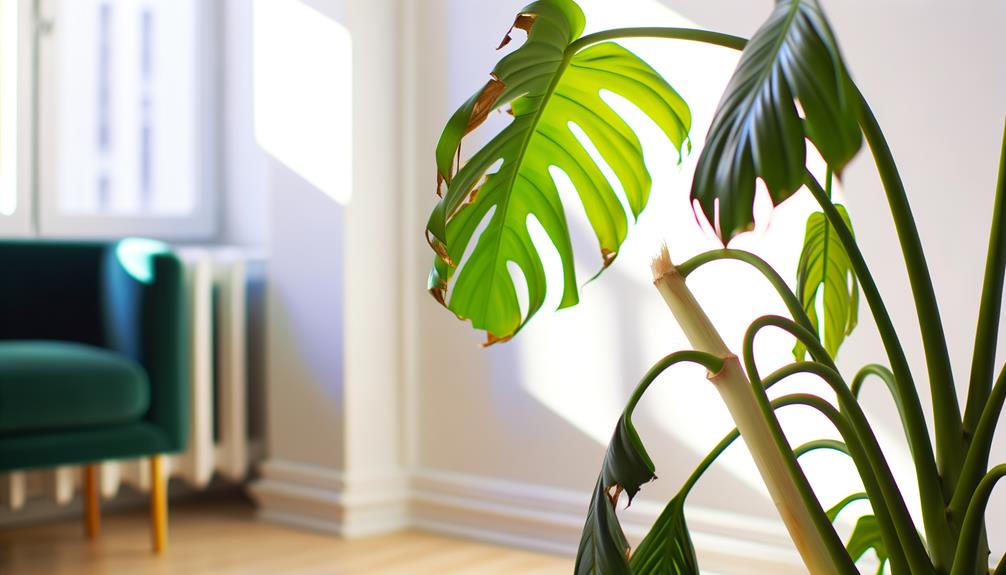
Physical damage to your Monstera plant can lead to drooping leaves, making it crucial to inspect for any signs of trauma or mechanical injury.
Abrasions, broken stems, or torn leaves can disrupt the plant’s vascular system, hindering nutrient and water transport.
Examine the plant’s structure, focusing on areas where damage might’ve occurred due to handling or environmental factors.
Verify that pets or children haven’t caused harm.
If you identify damaged areas, prune them using sterilized tools to prevent infection.
Supporting the plant with stakes or ties can alleviate stress on compromised sections.
Consistent monitoring will help in early detection and management of physical injuries, guaranteeing your Monstera recovers efficiently and maintains its structural integrity.
Natural Aging
As Monstera plants mature, it’s common for older leaves to droop and eventually die off, signaling the plant’s ongoing life cycle and energy allocation. This is a normal physiological process. The plant reallocates resources to newer growth, enhancing overall health.
Key indicators of natural aging include:
- Leaf discoloration: Typically yellowing before drooping.
- Location: Older leaves at the base of the plant are primarily affected.
- Consistency: Gradual, not sudden, leaf decline.
Understanding this helps you distinguish between natural aging and other issues like pests or overwatering.
Regularly prune aging leaves to maintain plant well-being and aesthetics. This process not only keeps your Monstera vibrant but also encourages new growth by reallocating resources efficiently.
Conclusion
In summation, solving your drooping monstera dilemma demands diligence. Determining between overwatering or underwatering necessitates nuanced analysis. Lighting levels, temperature tolerance, and humidity harmony must be meticulously managed.
Pest problems require rapid response, while nutrient needs necessitate careful calibration. Physical damage and natural aging also warrant watchful consideration. By applying these expert insights with alliterative accuracy, you’ll foster a flourishing, formidable monstera.
Stay steadfast and your plant will prosper.






